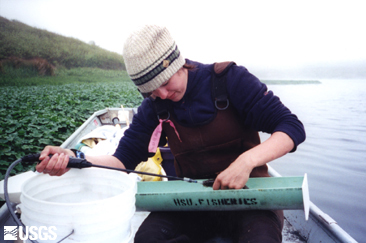- Home
- About S&T
- Taxa/Organisms
- Ecosystems
- Issues
- Methods & Tools
- Reports & Publications
- Location
- Search
October 2008 | Publisher: USGS (Soundwaves) | Format: URL
soundwaves.usgs.gov — Three years after Hurricanes Katrina and Rita ravaged the U.S. Gulf Coast, the region was hit once again by a pair of large storms: Hurricane Gustav made landfall near Cocodrie, Louisiana, on September 1, 2008, as a strong Category 2 storm; and Hurricane Ike made landfall near Galveston, Texas, on September 13, 2008, also as a strong Category 2 More...

2008 | Publisher: USGS | Format: URL
soundwaves.usgs.gov — U.S. Geological Survey (USGS)'s Western Region held an internal USGS workshop on Sea-Level-Rise Impacts on November 6-7, 2007, in Menlo Park, California. The meeting was attended by 30 scientists from four USGS disciplines (geology, geography, biology, and water) and 13 different science centers in the Western Region. In part a follow-up to the More...
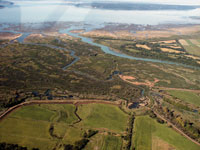
Publisher: USGS | Format: URL
pubs.er.usgs.gov — This report presents the results of the 2006 International Census of Piping Plovers (Charadrius melodus). Two sets of tabular data are reported: one for distribution and abundance of wintering Piping Plovers, the other for distribution and abundance of breeding Piping Plovers. The winter census resulted in the observation of 3,884 Piping Plovers More...

Publisher: USGS | Science Center: Western Fisheries Research Center (WFRC, Seattle) | Format: URL
wfrc.usgs.gov — Ballast water discharges are the most significant cause of aquatic biological invasions in coastal waters, including the Great Lakes. Currently, treatment of ballast water prior to discharge at the receiving port offers significant promise to help control this problem. However, development of treatment technologies is limited by lack of objective More...

Publisher: USGS | Science Center: Alaska Science Center (ASC, Anchorage) | Format: URL
alaska.usgs.gov — It is estimated that 100,000-150,000 Bar-tailed Godwits breed in Alaska. Under the US Shorebird Conservation Plan, they are a species of High Concern mainly due to their small population size, threats to their non-breeding grounds (especially at migratory stopover sites in Asia), and their relatively restricted breeding distribution within the More...
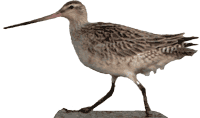
Publisher: USGS | Science Center: Western Ecological Research Center (WERC, Sacramento) | Format: URL
www.werc.usgs.gov — Sea otters (Enhydra lutris) are keystone predators in the nearshore environment of the eastern Pacific Ocean, in a food web composed of sea otter, sea urchin, and kelp forest. Without sea otters, the kelp forest can be overgrazed by sea urchins, which in turn can affect other species that depend on this ecosystem. This resource provides links to More...
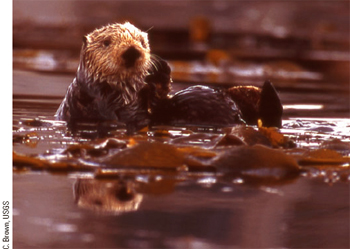
Publisher: USGS | Science Center: Western Ecological Research Center (WERC, Sacramento) | Format: URL
www.werc.usgs.gov — Once an abundant frog throughout much of central and southern California, the California red-legged frog (Rana draytonii) is now rare in the Sierra Nevada foothills and the southern portion of its range. In parts of the central Coast Range, however, large, vigorous populations do remain. Most protection efforts for this threatened species have More...
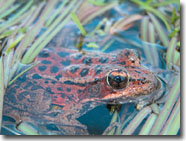
Publisher: USGS (Biological Science Office) | Science Center: Alaska Science Center (ASC, Anchorage) | Format: URL
www.absc.usgs.gov — This project was designed to assess whether or not populations are recovering, whether isolated processes constrain recovery, and the potential activities to facilitate recovery. This web resource provides links to background information on Nearshore Vertebrate Predators, the Sea Otter, the Harlequin Duck, the River Otter, and the Pigeon More...

Publisher: USGS | Science Center: Upper Midwest Environmental Sciences Center (UMESC, LaCrosse) | Format: URL
www.umesc.usgs.gov — Scientists with the U.S. Geological Survey and the Wisconsin Department of Natural Resources are evaluating a new way of monitoring movements and behavior of common loons. Miniature archival geolocator tags were attached to 18 adult common loons in northern Wisconsin this past summer.

Publisher: USGS | Science Center: Alaska Science Center (ASC, Anchorage) | Format: URL
alaska.usgs.gov — This resource is a life history profile of the Bristle-thighed Curlew (Numenius tahitiensis). The Bristle-thighed Curlew (Numenius tahitiensis) breeds only in North America. Its adult population numbers about 7,000 individuals, making it the rarest of the New World curlews and godwits. It is similar in appearance to the Whimbrel (N. phaeopus). More...
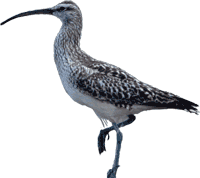
Publisher: USGS | Science Center: Upper Midwest Environmental Sciences Center (UMESC, LaCrosse) | Format: URL
www.umesc.usgs.gov — Little is known about the movements of common loons (Gavia immer) during migrations and on wintering ranges in coastal waters. This information is needed to formulate effective regional and national conservation strategies. UMESC has collaborated with regional partners in the use of satellite telemetry to study the movements of common loons More...

Publisher: USGS | Science Center: Western Fisheries Research Center (WFRC, Seattle) | Format: URL
wfrc.usgs.gov — This study was conducted to investigate the inventory, relative abundance, and spatial distribution of fish inhabiting Abbots Lagoon, California. Distribution patterns of the fish were related to water quality or other environmental conditions in the lagoon. Specific objectives of this investigation were to (a) inventory the fish species More...
